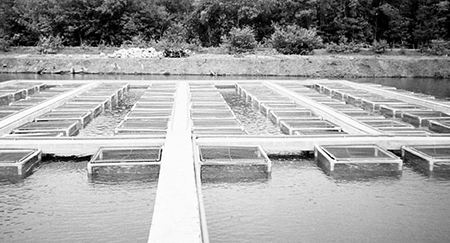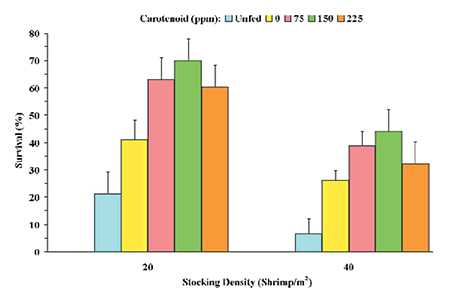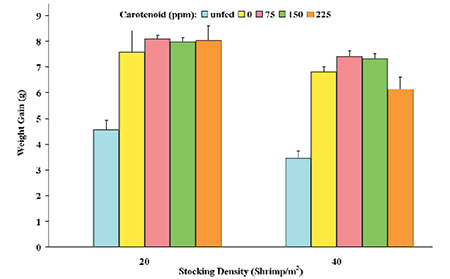Preliminary testing indicates increased shrimp survival rates

Variability in the severity of white spot syndrome virus outbreaks can be correlated to seasonal and environmental factors, suggesting an interaction between the disease and stress factors. In some cases, shrimp survive exposure to WSSV, but the presence of additional stress factors can cause an acute outbreak of the disease.
Treatments or management strategies that improve the condition of shrimp can potentially increase resistance to disease, and maintain chronically infected shrimp without the development of massive mortalities.
A number of food additives – including vitamin C, bacteria and yeast byproducts, peptides, betaglucans, astaxanthin, and others – are being tested for their potential to stimulate the immune systems of shrimp. Results from a recent growth trial indicate that dietary supplementation with carotenoids may increase resistance to disease and reduce mortality in infected populations of shrimp.
Importance of carotenoids
Carotenoids are fat-soluble pigments that are structurally related to β-carotene, the main source of vitamin Ain animals. Only plants and some microorganisms synthesize carotenoids. Animals must depend upon dietary sources of carotenoids for metabolic requirements in addition to pigmentation.
Carotenoids perform a wide range of essential biological functions, many of which may increase resistance to disease. These include stabilization of proteins, membranes, and chitin; wound healing; immune response; growth; endocrine functions; and antioxidant protection.
Growth trial

The effect of a carotenoid feed additive on growth and survival of Litopenaeus vannamei was recently evaluated in a growth trial at Biocultivos Manabitas, Bahía de Caráquez in Manabí, Ecuador. Under conditions where the shrimp were exposed to WSSV, TSV, and IHHNV, high mortality was anticipated.
To eliminate the effects of inter-pond variability, the growth trial was conducted in 1-m2 bottomless cages in a single 0.32-ha pond (Fig. 1). In each cage, a 5-cm-diameter directional airlift provided aeration and water movement. Shrimp weighing 5.5 grams were stocked in the cages at densities of 20 or 40 shrimp per square meter.
Prior to stocking, shrimp were reared from postlarvae in lined ponds. WSSV was endemic to the site, and pathological analysis indicated the population of animals contained WSSV infection. Water treatments during filling and the eight-week growth trial were similar to those used for surrounding commercial culture ponds.
Feeds used
Feeds with three different levels of a trademarked carotenoid supplement, Hi-Zea, were compared to standard feed. Hi-Zea is a carotenoid feed additive manufactured to increase pigmentation, survival, and feed conversion in shrimp. The carotenoid additive contains 0.5 percent β-carotene and a high percentage of xanthophylls (pigmenting oxycarotenoids). Its concentration of total xanthophylls is 30 grams per kilograms. The xanthophylls present are 2 percent cryptoxanthin, 10 to 15 percent lutein, and 70 to 75 percent zeaxanthin.
Animals were fed 0.20 g feed per shrimp per day. Proximate and carotenoid analyses of the feeds are shown in Table 1.
Castille, Proximate analysis and carotenoid content of feeds, Table 1
| Feed (ppm carotenoid) | 0 | 75 | 150 | 225 |
|---|
Feed (ppm carotenoid) | 0 | 75 | 150 | 225 |
|---|---|---|---|---|
| Proximate analysis (%)* | ||||
| Protein | 30 | 34 | 36 | 36 |
| Lipid | 5 | 9 | 9 | 8 |
| Fiber | 3 | 2 | 2 | 2 |
| Ash | 9 | 8 | 8 | 8 |
| Carotenoid (ppm)** | ||||
| Days 1-23 | 13 | 67 | 108 | 96 |
| Days 24-35 | 18 | 68 | 142 | 186 |
| Days 36-56 | 18 | 68 | 142 | 232 |
** Research and Development Department, Industrial Orgánica, S.A., Monterrey, N.L., México
Table 1. Proximate analysis and carotenoid content of feeds.
The feeds were pelleted by Empacadora Nacional of Guayaquil, Ecuador. Hi-Zea was mixed with fish oil and sprayed on the pellets after drying. Shrimp fed on the experimental feeds for the first 23 days of the growth trial.
After analysis of feeds indicated that carotenoid levels were below target levels in the 150- and 225-ppm feeds, levels were corrected by spraying additional carotenoid concentrate on the pellets. The corrected 150-ppm feed was used for the remainder of the trial (days 24 to 56). The corrected 225-ppm feed, which was used for days 24 to 35, was still below the target level. The carotenoid level was corrected again and used for the remainder of the trial.
Results
Growth and survival at harvest were analyzed by twoway analysis of variance. Interactions between stocking density and diet were not significant for growth or survival.
Survival

Survival (Fig. 2) was greater at the stocking density of 20 shrimp per square meter than at 40 shrimp per square meter. At 20 shrimp per square meter, survival ranged from 21 to 70 percent, and at 40 shrimp per square meter, it ranged from 7 to 39 percent. At both stocking densities, survival was greater for fed than unfed shrimp.
At both stocking densities, survival was greater using feed containing the Hi-Zea carotenoid supplementation. Differences in survival using feeds with different levels of carotenoid were not significant.
Growth
Growth was greater at the stocking density of 20 shrimp per square meter than at 40 shrimp per square meter (Fig. 3). At 20 shrimp per square meter, weight gains ranged from 4.6 to 8.1 grams; at 40 shrimp per square meter, they ranged from 3.5 to 7.4 grams. At both stocking densities, growth was greater for fed than unfed shrimp, and differences in growth due to feeds were not significant.
Pathological analysis
At harvest, hemolymph from shrimp fed the 0- and 150- ppm carotenoid feeds at the stocking density of 20 shrimp per square meter was sampled for pathological analysis by Concepto Azul of Guayaquil, Ecuador. PCR tests for IHHNV and WSSV; and immune-blot dot tests for IHHNV, WSSV, and TSV indicated high levels of infection by all three viruses in both groups of shrimp.
Conclusions
The growth trial demonstrated that dietary carotenoid can increase survival of shrimp in the presence of WSSV, IHHNV, and TSV infections. The levels of carotenoids used, however, did not affect survival. This may have been caused by the fact that the feed carotenoid levels were below target levels for 23 of 56 days on the 150-ppm feed, and 35 of 56 days on the 225-ppm feed.
Results of this study suggest that carotenoids can be an effective tool to decrease the severity of mass mortalities caused by WSSV and other viral pathogens. However, carotenoids are not a cure, and mortality in this study was substantial in all treatments.
The effectiveness of dietary supplementation with carotenoids will depend upon the severity of infection and other cumulative stress factors that affect the condition of the shrimp. Increased survival was significant in this trial, but may not occur under different culture conditions.
(Editor’s Note: This article was originally published in the October 2000 print edition of the Global Aquaculture Advocate.)
Now that you've finished reading the article ...
… we hope you’ll consider supporting our mission to document the evolution of the global aquaculture industry and share our vast network of contributors’ expansive knowledge every week.
By becoming a Global Seafood Alliance member, you’re ensuring that all of the pre-competitive work we do through member benefits, resources and events can continue. Individual membership costs just $50 a year. GSA individual and corporate members receive complimentary access to a series of GOAL virtual events beginning in April. Join now.
Not a GSA member? Join us.
Authors
-
-
-
-
Geovany Alvarado
Biocultivos Manabitas
-
José Torres
Industrial Orgánica, S.A. de C.V.
-
-
Raúl Cortez
Industrial Orgánica, S.A. de C.V.
-
Tagged With
Related Posts

Health & Welfare
Add value to shrimp harvests: Darken environment to enhance shrimp color
Shrimp color is caused by pigments that play an important role in camouflage for survival. For farmed shrimp, proper coloration is generally achieved via synthetic astaxanthin in feed.

Health & Welfare
Finishing diet improves sea bream quality
A finely tuned fishing diet can improve growth and feed utilization of sea bream grown previously on diets with low levels of fishmeal and fish oil.

Health & Welfare
Alfalfa concentrate: natural shrimp color enhancer
Adding alfalfa concentrate containing natural carotenoids and pigments to the finishing diets of shrimp can enhance coloration of shrimp after cooking.

Aquafeeds
The pink powder that could revolutionize aquaculture
KnipBio, a Massachusetts-based biotechnology startup founded in 2013, is refining the manufacturing process for a promising aquaculture feed ingredient that may one day form the foundation of the food that farmed fish eat.


